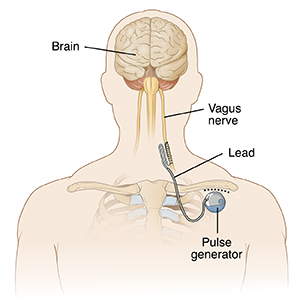Understanding Vagus Nerve Stimulator (VNS) Placement
A vagus nerve stimulator (VNS) is a device that can help prevent seizures. It is FDA-approved for the treatment of epilepsy and depression. A VNS has 2 parts: a pulse generator and leads. The pulse generator sits in your chest under your skin. The leads run from the generator to the vagus nerve in your neck. The VNS is put in your body during surgery.

What are the vagus nerves?
The vagus nerves are long nerves that travel from your brain. You have one vagus nerve on the left and one on the right. They lead down through your neck and into your chest and belly (abdomen). Each nerve has branches that go to your vocal cords, to some of the muscles of your throat, to your heart, and to other organs in your body.
How a VNS works
The ends of the VNS leads wrap around your left vagus nerve. The VNS is a lot like a pacemaker. The pulse generator creates low-energy electrical signals. The leads carry those signals to the vagus nerve. The pulse generator is programmed through the skin. The strength, length, and frequency of the pulses can be changed as needed. A VNS can also improve mood. It can be used to treat depression that hasn't responded to other treatments. Sometimes a person can reduce the chance of a seizure starting by activating the stimulator with a special wand.
Why a VNS is used
Seizures caused by epilepsy are often treated with medicines. But sometimes the medicines don’t work well or have severe side effects. Seizures can also be treated with a diet high in fat and low in carbohydrates (ketogenic diet). Brain surgery is another treatment. But sometimes these aren't choices. A VNS may be used to treat seizures from epilepsy if:
-
Medicine doesn’t control your seizures
-
You can’t follow a ketogenic diet
-
You still have seizures while on a ketogenic diet
-
You don’t want to or are not able to have brain surgery
-
You had brain surgery, but you still have seizures
A VNS may be advised for you if you have severe depression that is hard to treat.
Risks of having a VNS
All procedures have some risks. The risks of surgery to place a VNS may include:
Possible side effects of VNS
After a VNS is in place, it may cause some problems, such as:
-
Hoarse voice (most common)
-
Cough
-
Sore throat
-
Trouble swallowing
-
Shortness of breath
-
Tingling
-
Nausea and vomiting
-
Sleep apnea that gets worse in people who already have it
-
New sleep apnea in people at risk for it
-
Broken lead
-
Leads not in the correct position
-
Malfunction of the pulse generator
Most VNS side effects will get better or go away with adjustment of the VNS settings. If you have sleep apnea, using a continuous positive airway pressure (CPAP) machine while you sleep may help.